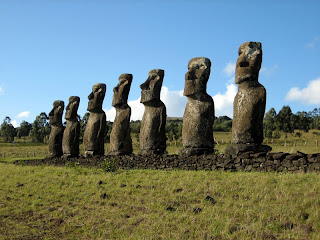The
Weird, mysterious and isolated
There are many places on earth with some sort of fascinations, but
From where did these inhabitants come why did they built so many gigantic statues (these statues are known as Moais), how did those people bring these stones to this remote island, what technology they used for the transportation? More over why have they toiled to make such gigantic statues? These are questions that intrigue visitors as well as those are interested archaeology. In 1722 one sailor by name Admiral Reggeveen landed on this island that was an Easter day; hence he named that island
Special territory
The capital of
Moais (the statues)
Had there been no moais; the
Coral eye and scoria pupil
As per Sonia Haoa and archaeologist these statues were made with eye sockets capable to hold white corals as eyes with scoria (a volcanic stone with shining black color) as its pupil, she has demonstrated the statement by collecting the fragments of corals and scoria retrieved around the statues and reconstructing it to its original shapes.
The tallest and he heaviest
The tallest moai (known as Paro) is 10 meters (33 feet) in height and weigh 75 tons, where as the heaviest is 86 tons in weight; it is placed on a platform by name Ahu Tongariki. There is one unfinished moai; which if completed would have been the tallest and the heaviest (21 meter in height and 240 tons in weight!) Most of the moais are found in Ranu Roraku the moai quarry; recently hundreds of them have been transported to set them on the ahus (the platform for placing moais). The moais were originally placed on ahus with their back facing the sea.
A baby boom and after !
The
Scapegoats of a tragedy !
People who were dying of hunger turned to cannibalism; they started killing and eating their neighbors! Their frustration later turned against the moais which were standing there as if they were mere spectators of these horrible scenes. The moais were dragged by the violent mob and got dumped in to a waste land. These statues were there for centuries until recently and they were reinstalled in proper places by the joint initiative of UNESCO and the government.
A nostalgic past
In 1950 Heyer Dahl the famous Norwegian explorer (his work the ‘Kon tiki Expedition’ was a classic) happened to visit made the existence such an isolated island popular, this aroused curiosity among sailors. His theory about the original inhabitants has been proved wrong and it has been established that the people were of Polynesian stocks. As per the latest opinions it must be a set of less than 100 people probably lost their way on the sea and happened to land and stay here. The lush forests with small animals, flightless birds, and rich fish of the sea shore were more than what they bargained for!
Life as a dream!
If what the archaeologists say are true this island’ original culture was enough create jealousy among the modern men, the isolation to which these people were subjected worked in forming an exclusive lifestyle for its inhabitants. Enough food and leisure aroused in them hidden creative talents; for which they toiled and suffered to bring huge stones from nearby sea-rocks, cut huge trees barked them for artworks every thing they could lay hands on; stones, wood, barks of trees, their own body skin, virtually every where they could work turned out to be their canvass. Dance and music was their favorite time pass.
Survived to tell their story
Life for them was devotion and they went on giving birth to beautiful art works from birth to death! They made it every where; they tattooed their own body with fine arts. But alas bark of wood, body skin every thing perished by the passing of time but these hard stones out of which they made these immortal statues alone survived the test of time! They survived the time of cannibalism; and stand tall declaring the greatness of their creators!
How to get there ?
There are regular flights from
Brilliant landscapes and Tapati
The natives are a jolly lot and their most important festival is the Tapati Festival which is celebrated during January and February. The festival of 2008 is nearing and a visit during this time is real joy!





2 comments:
cheers..... good article
I wonder, is there any surf there? does anyone know?
Post a Comment